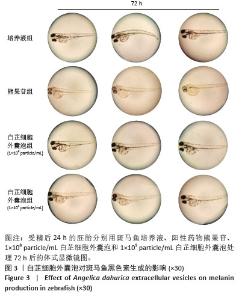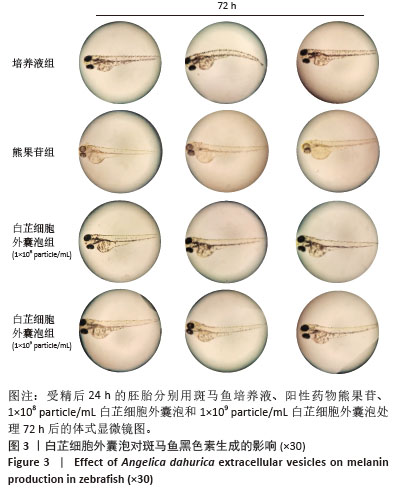Chinese Journal of Tissue Engineering Research ›› 2026, Vol. 30 ›› Issue (7): 1747-1754.doi: 10.12307/2026.310
Previous Articles Next Articles
Ideas and methods of anti-melanogenesis of Angelica dahurica extracellular vesicles
Zhou Sirui1, Xu Yukun1, Zhao Kewei2
- 1Third Clinical Medical College, Guangzhou University of Chinese Medicine, Guangzhou 510378, Guangdong Province, China; 2Department of Laboratory Medicine, Third Affiliated Hospital of Guangzhou University of Chinese Medicine, Guangzhou 510378, Guangdong Province, China
-
Received:2025-02-05Revised:2025-06-13Accepted:2025-06-30Online:2026-03-08Published:2025-08-20 -
Contact:Zhao Kewei, MD, Chief technician, Department of Laboratory Medicine, Third Affiliated Hospital of Guangzhou University of Chinese Medicine, Guangzhou 510378, Guangdong Province, China -
About author:Zhou Sirui, MS, Third Clinical Medical College, Guangzhou University of Chinese Medicine, Guangzhou 510378, Guangdong Province, China
CLC Number:
Cite this article
Zhou Sirui, Xu Yukun, Zhao Kewei. Ideas and methods of anti-melanogenesis of Angelica dahurica extracellular vesicles[J]. Chinese Journal of Tissue Engineering Research, 2026, 30(7): 1747-1754.
share this article
Add to citation manager EndNote|Reference Manager|ProCite|BibTeX|RefWorks
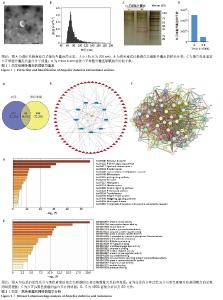
2.1 白芷细胞外囊泡的表征 超速差速离心法从白芷中提取出细胞外囊泡,透射电镜观测到白芷细胞外囊泡呈双分子层椭圆形状(图1A),通过纳米流式仪检测白芷细胞外囊泡的粒径、浓度,粒径在50-180 nm之间(图1B),蛋白条带显示白芷细胞外囊泡蛋白分子质量在30-35 kD之间(图1C)。Triton X-100破膜结果显示提取出来的白芷细胞外囊泡的纯度为82%(图1D)。 2.2 白芷内含物与黑色素瘤相关成分靶点的联系 在TCMSP数据库中检索“白芷”,设定筛选条件为生物利用度≥30%和类药性≥0.18,共筛选出17种有效成分。随后,通过Swiss Target Prediction数据库查询这些成分的SMILES号。在17种有效成分中,有8种未能找到相关靶点。经过合并与去重处理后,最终获得302个潜在靶点。此外,从GeneCards数据库中总共鉴定了999个黑色素瘤相关的靶标。如图2A所示,共鉴定了61个白芷和黑色素瘤的共同靶标。此外,网络药理图(图2B)进一步展示了白芷细胞外囊泡中活性化合物与色素沉着相关交集靶点之间的相互作用。 将白芷和黑色素瘤的61个共同靶点导入到STRING 11.5数据库中,构建蛋白互作网络图。如图2C所示,其中有2个与黑色素生成相关的核心蛋白MITF与GSK3β。 将白芷和黑色素瘤的交集靶点导入Metascape数据库进行GO富集分析和KEGG通路富集分析(图2D,E),其中GO分析主要是生物过程。"

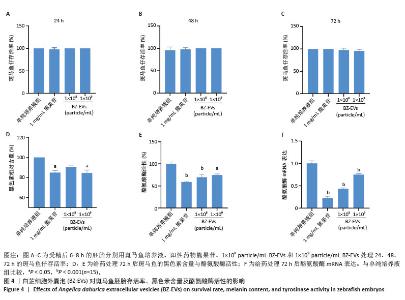
同时,评估不同浓度白芷细胞外囊泡(1×108 particle/mL,1×109 particle/mL)和熊果苷(1 mg/mL)对斑马鱼胚胎发育的影响,结果表明这些浓度均未对胚胎产生毒害作用(图4A-C)。随后,将给药后72 h的斑马鱼进行组织研磨,采用NaOH法检测黑色素含量,结果显示,与单纯培养液组相比,熊果苷组和1×109 particle/mL白芷细胞外囊泡组黑色素含量降低(P < 0.05)(图4D)。 2.4 白芷细胞外囊泡对斑马鱼胚胎酪氨酸酶的影响 为了证实白芷细胞外囊泡在斑马鱼胚胎中对酪氨酸酶的抑制作用,通过L-多巴氧化法来检测斑马鱼体内酪氨酸酶的活性[29],结果显示,在1×108 particle/mL白芷细胞外囊泡作用下,斑马鱼体内的酪氨酸酶浓度降低了30.3%,在1×109 particle/mL白芷细胞外囊泡作用下,斑马鱼体内的酪氨酸酶浓度降低了25.5%(图4E)。PCR实验结果显示,两种不同粒子数的白芷细胞外囊泡显著抑制了黑色素生成关键因子酪氨酸酶的表达,证明了白芷细胞外囊泡具有很好的降低黑色素生成的效果(图4F)。"
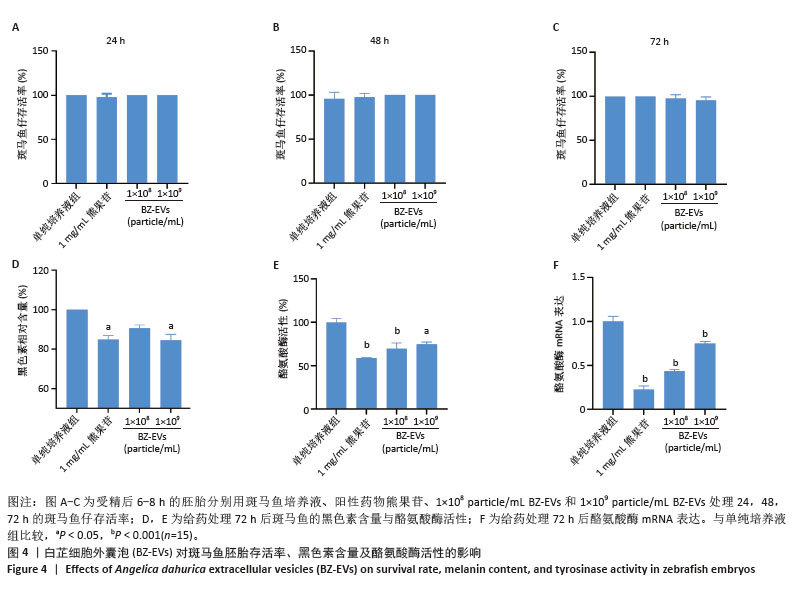
| [1] LI Y, XIAO Q, TANG J, et al. Extracellular Vesicles: Emerging Therapeutics in Cutaneous Lesions. Int J Nanomedicine. 2021;16:6183-6202. [2] HUMPHREY S, MANSON BROWN S, CROSS SJ, et al. Defining Skin Quality: Clinical Relevance, Terminology, and Assessment. Dermatol Surg. 2021;47(7):974-981. [3] BELLU E, MEDICI S, CORADDUZZA D, et al. Nanomaterials in Skin Regeneration and Rejuvenation. Int J Mol Sci. 2021;22(13):7095. [4] 何毅帆,龙芸鸾,李征,等.天然植物美白成分作用机理的研究进展[J].日用化学品科学,2022,45(10):37-43. [5] PROSPÉRI MT, GIORDANO C, GOMEZ-DURO M, et al. Extracellular vesicles released by keratinocytes regulate melanosome maturation, melanocyte dendricity, and pigment transfer. Proc Natl Acad Sci U S A. 2024;121(16):e2321323121. [6] JIANG X, YANG C, WANG Z, et al. Loss-of-function variants in GLMN are associated with generalized skin hyperpigmentation with or without glomuvenous malformation. Br J Dermatol. 2024;191(1):107-116. [7] SAMPEDRO-GUERRERO J, VIVES-PERIS V, GOMEZ-CADENAS A, et al. Encapsulation Reduces the Deleterious Effects of Salicylic Acid Treatments on Root Growth and Gravitropic Response. Int J Mol Sci. 2022;23(22):14019. [8] CHENG Y, ZHANG L, YOU Y. The effects of supramolecular nicotinamide combined with supramolecular salicylic acid on chloasma. J Cosmet Dermatol. 2024;23(2):681-686. [9] SEARLE T, AL-NIAIMI F, ALI FR. The top 10 cosmeceuticals for facial hyperpigmentation. Dermatol Ther. 2020;33(6):e14095. [10] PHILIPP-DORMSTON WG. Melasma: A Step-by-Step Approach Towards a Multimodal Combination Therapy. Clin Cosmet Investig Dermatol. 2024;17:1203-1216. [11] 郭聪颖.富硒绿豆发酵液面膜的研发和富硒黑茶的活性初探[D].上海:上海师范大学,2020. [12] 李薄薄,马洁,朱士强,等.抑制黑色素合成信号通路的植物美白原料的研究与开发[J].日用化学品科学,2023,46(3):21-28. [13] 马畅,李妍.白芷、白芍水和乙醇提取物对酪氨酸酶的抑制效应[J].香料香精化妆品,2023(2):54-58. [14] 鹿发展,刘平平,刘娟.白芨花提取物的美白、抗氧化和抗衰老功效研究[J].云南化工,2024,51(10):100-104. [15] 付媛媛,顾玲,何艳,等.洋甘菊提取物在化妆品中的应用研究进展[J].香料香精化妆品,2023(2):132-137. [16] ALBUQUERQUE PBS, DE OLIVEIRA WF, DOS SANTOS SILVA PM, et al. Skincare application of medicinal plant polysaccharides - A review. Carbohydr Polym. 2022;277:118824. [17] NG SY, EH SUK VR, GEW LT. Plant polyphenols as green sunscreen ingredients: A systematic review. J Cosmet Dermatol. 2022;21(11): 5409-5444. [18] POLERÀ N, BADOLATO M, PERRI F, et al. Quercetin and its Natural Sources in Wound Healing Management. Curr Med Chem. 2019;26(31): 5825-5848. [19] LAN J, SUN L, XU F, et al. M2 Macrophage-Derived Exosomes Promote Cell Migration and Invasion in Colon Cancer. Cancer Res. 2019;79(1): 146-158. [20] CHUNG CC, CHAN L, CHEN JH, et al. Plasma extracellular vesicles tau and β-amyloid as biomarkers of cognitive dysfunction of Parkinson’s disease. FASEB J. 2021;35(10):e21895. [21] KESHTKAR S, AZARPIRA N, GHAHREMANI MH. Mesenchymal stem cell-derived extracellular vesicles: novel frontiers in regenerative medicine. Stem Cell Res Ther. 2018;9(1):63. [22] 鲍少杰.虾青素对肠道炎症的影响及西兰花胞外囊泡载虾青素体系构建[D].扬州:扬州大学,2021. [23] LI C, SONG Q, YIN X, et al. Preparation, Characterization, and In Vitro Anticancer Activity Evaluation of Broccoli-Derived Extracellular Vesicle-Coated Astaxanthin Nanoparticles. Molecules. 2022;27(12):3955. [24] CONG L, MA J, ZHANG Y, et al. Effect of anti-skin disorders of ginsenosides- A Systematic Review. J Ginseng Res. 2023;47(5):605-614. [25] GABRIELLI M, BATTISTA N, RIGANTI L, et al. Active endocannabinoids are secreted on extracellular membrane vesicles. EMBO Rep. 2015; 16(2):213-220. [26] COSSETTI C, IRACI N, MERCER TR, et al. Extracellular vesicles from neural stem cells transfer IFN-γ via Ifngr1 to activate Stat1 signaling in target cells. Mol Cell. 2014;56(2):193-204. [27] PARK JJ, HWANG SJ, KANG YS, et al. Synthesis of arbutin-gold nanoparticle complexes and their enhanced performance for whitening. Arch Pharm Res. 2019;42(11):977-989. [28] DING Y, JIANG Y, IM ST, et al. Diphlorethohydroxycarmalol inhibits melanogenesis via protein kinase A/cAMP response element-binding protein and extracellular signal-regulated kinase-mediated microphthalmia-associated transcription factor downregulation in α-melanocyte stimulating hormone-stimulated B16F10 melanoma cells and zebrafish. Cell Biochem Funct. 2021;39(4):546-554. [29] SHI G, FENG Y, TONISSEN KF. Development of a human tyrosinase activity inhibition assay using human melanoma cell lysate. Biotechniques. 2024;76(11):547-551. [30] 朱翠翠.调节黑色素生成的主要信号通路[J].日用化学品科学, 2023,46(7):61-70. [31] WANG Z, ZHANG D, SHUI M, et al. Investigation of the whitening activity of ginsenosides from Panax notoginseng and optimization of the dosage form. J Ginseng Res. 2024;48(6):543-551. [32] SANJAYA SS, PARK MH, KARUNARATHNE WAHM, et al. Inhibition of α-melanocyte-stimulating hormone-induced melanogenesis and molecular mechanisms by polyphenol-enriched fraction of Tagetes erecta L. flower. Phytomedicine. 2024;126:155442. [33] CHO J, JUNG H, KANG DY, et al. The Skin-Whitening and Antioxidant Effects of Protocatechuic Acid (PCA) Derivatives in Melanoma and Fibroblast Cell Lines. Curr Issues Mol Biol. 2023;45(3):2157-2169. [34] TUNG XY, YIP JQ, GEW LT. Searching for Natural Plants with Antimelanogenesis and Antityrosinase Properties for Cosmeceutical or Nutricosmetics Applications: A Systematic Review. ACS Omega. 2023;8(37):33115-33201. [35] CAI CS, HE GJ, XU FW. Advances in the Applications of Extracellular Vesicle for the Treatment of Skin Photoaging: A Comprehensive Review. Int J Nanomedicine. 2023;18:6411-6423. [36] JANG B, CHUNG H, JUNG H, et al. Extracellular Vesicles from Korean Codium fragile and Sargassum fusiforme Negatively Regulate Melanin Synthesis. Mol Cells. 2021;44(10):736-745. [37] CHAMBERS ES, VUKMANOVIC-STEJIC M. Skin barrier immunity and ageing. Immunology. 2020;160(2):116-125. [38] ZHAO B, LIN H, JIANG X, et al. Exosome-like nanoparticles derived from fruits, vegetables, and herbs: innovative strategies of therapeutic and drug delivery. Theranostics. 2024;14(12):4598-4621. [39] WOITH E, GUERRIERO G, HAUSMAN JF, et al. Plant Extracellular Vesicles and Nanovesicles: Focus on Secondary Metabolites, Proteins and Lipids with Perspectives on Their Potential and Sources. Int J Mol Sci. 2021;22(7):3719. [40] NATANIA F, IRIAWATI I, AYUNINGTYAS FD,et al. Potential of Plant-derived Exosome-like Nanoparticles from Physalis peruviana Fruit for Human Dermal Fibroblast Regeneration and Remodeling. Pharm Nanotechnol. 2025;13(2):358-371. |
| [1] | Chen Yulin, He Yingying, Hu Kai, Chen Zhifan, Nie Sha Meng Yanhui, Li Runzhen, Zhang Xiaoduo , Li Yuxi, Tang Yaoping. Effect and mechanism of exosome-like vesicles derived from Trichosanthes kirilowii Maxim. in preventing and treating atherosclerosis [J]. Chinese Journal of Tissue Engineering Research, 2026, 30(7): 1768-1781. |
| [2] | Peng Zhiwei, Chen Lei, Tong Lei. Luteolin promotes wound healing in diabetic mice: roles and mechanisms [J]. Chinese Journal of Tissue Engineering Research, 2026, 30(6): 1398-1406. |
| [3] | Chen Yixian, Chen Chen, Lu Liheng, Tang Jinpeng, Yu Xiaowei. Triptolide in the treatment of osteoarthritis: network pharmacology analysis and animal model validation [J]. Chinese Journal of Tissue Engineering Research, 2026, 30(4): 805-815. |
| [4] | Chen Yueping, Chen Feng, Peng Qinglin, Chen Huiyi, Dong Panfeng . Based on UHPLC-QE-MS, network pharmacology, and molecular dynamics simulation to explore the mechanism of Panax notoginseng in treating osteoarthritis [J]. Chinese Journal of Tissue Engineering Research, 2025, 29(8): 1751-1760. |
| [5] | Jiang Qiyu, Zeng Huiyan. A novel analysis and prediction method for potential mechanisms of traditional Chinese medicine based on artificial intelligence and omics data-driven approach [J]. Chinese Journal of Tissue Engineering Research, 2025, 29(35): 7552-7561. |
| [6] | Wang Tong, Zheng Yu, Jia Chengming, Yang Hu, Zhang Guangfei, Ji Yaoyao. Action mechanism of Gegenmaqi prescription in treatment of periarthritis of shoulder combined with type 2 diabetes based on TCMSP database [J]. Chinese Journal of Tissue Engineering Research, 2025, 29(35): 7669-7678. |
| [7] | Fang Yuan, Qian Zhiyong, He Yuanhada, Wang Haiyan, Sha Lirong, Li Xiaohe, Liu Jing, He Yachao, Zhang Kai, Temribagen. Mechanism of Mongolian medicine Echinops sphaerocephalus L. in proliferation and angiogenesis of vascular endothelial cells [J]. Chinese Journal of Tissue Engineering Research, 2025, 29(35): 7519-7528. |
| [8] | Zhang Xin, Guo Baojuan, Xu Huixin, Shen Yuzhen, Yang Xiaofan, Yang Xufang, Chen Pei. Protective effects and mechanisms of 3-N-butylphthalide in Parkinson’s disease cell models [J]. Chinese Journal of Tissue Engineering Research, 2025, 29(30): 6466-6473. |
| [9] | Qi Junlong, Liu Junyi, He Yuzhou, Qiang Wei, Zhang Shiying, Liu Qiao, Zhu Hongda. Functionalized self-assembled micelles enhance effect of tranexamic acid in treatment of cutaneous hyperpigmentation [J]. Chinese Journal of Tissue Engineering Research, 2025, 29(28): 6061-6069. |
| [10] | Li Su, Wang Qinghua, Da Mengting, Yang Rui, Chen Daozhen. Action mechanism by which gambogic acid down-regulates expression of protein C receptor to kill triple negative breast cancer stem cells [J]. Chinese Journal of Tissue Engineering Research, 2025, 29(23): 4888-4898. |
| [11] | Lai Yue, Lin Xuan, Xu Miao, Liu Huan, Shen Jianlin, Huang Wenhua. Medication pattern and mechanism of marine traditional Chinese medicine in the treatment of osteoporosis [J]. Chinese Journal of Tissue Engineering Research, 2025, 29(17): 3713-3723. |
| [12] | Gu Yufeng, Deng Bingying, Li Niren, Zeng Yixuan, Lu Sifan, Zhu Chen, Chen Lei, Liu Yi. Mechanisms of total flavonoids from Sophora flavescens for the treatment of non-alcoholic fatty liver disease and experimental validation in zebrafish [J]. Chinese Journal of Tissue Engineering Research, 2025, 29(14): 2969-2978. |
| [13] | Zhang Wensheng, Guo Haiwei, Weng Rui, Mo Ling, Song Zhenjie, Tian Han, Zhong Yelin, Wang Yuancheng, Tang Hanwu, Liu Caijun, Yuan Chao, Li Ying. Liquiritin inhibits osteoclast differentiation and alleviates bone loss [J]. Chinese Journal of Tissue Engineering Research, 2025, 29(12): 2429-2437. |
| [14] | Zhang Tiandong, Peng Qingping, Liu Huan, Feng Jianguo, Yi Qian, Huang Wenhua. Semen cuscutae in the treatment of osteoarthritis: network pharmacology analysis and experimental validation [J]. Chinese Journal of Tissue Engineering Research, 2024, 28(28): 4516-4521. |
| [15] | Yang Jingyan, Ma She, Huang Renjun, Yang Xiaoxia, Tang Xiaochen, Yu Dong. Yougui Pill in the treatment of lumbar disc herniation: network pharmacological analysis of active ingredients and potential targets [J]. Chinese Journal of Tissue Engineering Research, 2024, 28(27): 4346-4352. |
| Viewed | ||||||
|
Full text |
|
|||||
|
Abstract |
|
|||||
